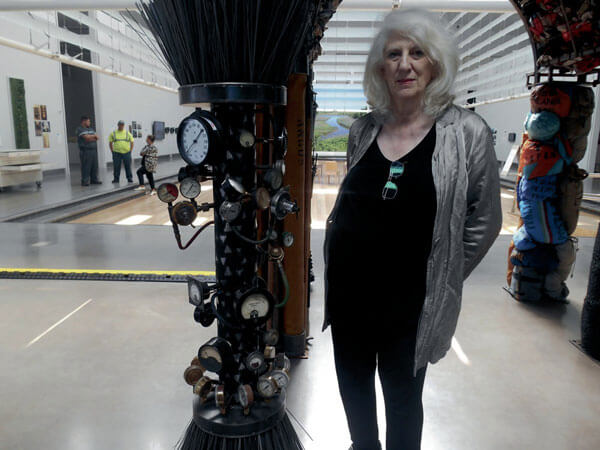By Merle Exit
If you happen to be at Flushing Meadows Corona Park and see an odd sanitation truck at the east entrance to the Queens Museum, chances are that it’s not there to pick up garbage. Instead, it is one of many works at the museum that are part of the exhibit “Mierle Laderman Ukeles: Maintenance Art,” which is up through Feb. 19, 2017.
Created in 1983 and featured in the grand finale of a New York City art parade, the truck/art piece is covered with mirrored glass which captures the image of the Unisphere. Ukeles, the longtime Artist-in-Residence at New York’s Department of Sanitation, said at preview event for the exhibit that it was made to help sanitation workers “see themselves captured in their job so that they are not outside, but part of the story. Our biggest challenge is how we deal with our waste and the effects of our living in the whole world now.”
Ukeles came to her position with the Department of Sanitation after addressing those issues in her work. In 1969 she first created what she called “necessity art,” which she later named Maintenance Art. She even wrote a “Manifesto for Maintenance Art.” So perhaps it was inevitable that in the 1970s she would get a call from the Sanitation Department asking if she would like to make art with 10,000 New York City workers.
A museum within a museum, her exhibit encompasses all of the first floor gallery areas including the walls and center space. In it, Ukeles charts her work in terms of both feminist and conceptual performance, referencing both her unsalaried career with the Department of Sanitation and her work as an artist whose Jewish faith has fueled her belief in the capacity of the human spirit.
“Ceremonial Arch,” which is displayed at the entrance of the exhibition, honors service workers. The arch is composed of 5,000 used, signed work gloves from workers at New York’s Fire, Police, Sanitation, Environmental Protection, Parks, Cultural Affairs and Transportation Departments, as well as the Metropolitan Transit Authority. The arch is topped with a canopy of tools used by ConEd workers, placed over six sturdy columns.
“The black gloves that you see at the entry are from the Fire Department,” Ukeles explained. She recounted her memories of 9/11, having had some of her art displayed at a firehouse in the Bronx. Michael Judge, the chaplain of the Fire Department, blessed her work.“I put the gloves at the entrance as if to bless everyone for the sacrifice of their lives.”
Just beyond the arch sits “Peace Table,” a clear blue glass table suspended under the center skylight. Its purpose is to engage and contemporize important themes of the exhibition. Public programs will be held here, such as one with Cultural Affairs Commissioner Tom Finkelpearl that was held last month.
The exhibit also incorporates many other art forms—photographs and structures, as well as media that include video on screens and monitors. There are interactive displays and one featuring a book where you view a hand turning the pages. For works entitled “Touch Sanitation Performance,” Mierle spent a year visiting each New York Department of Sanitation districts to shake the hand of every one of the 8,500 workers who were willing to accept her gesture.
Vito Turso, who was just starting out at the department when Ukeles started out as Artist-in-Residence nearly 40 years ago, was present when Ukeles sent along her manifesto on art. “It was the first time that anyone really thanked the sanitation workers for what they do,” said Turso. “It was Mierle that brought all of this to our department. I am honored to be here on behalf of Commissioner Garcia. He referred to her as the “patron saint of Sanitation”.
The exhibition is organized by Queens Museum curator Larissa Harris and guest co-curator Patricia C. Phillips, who initiated the project in 2012 with Tom Finkelpearl.
Ukeles and her husband, Jack, currently live in Tel Aviv, to be closer to their three adult children and seven grandchildren.


































